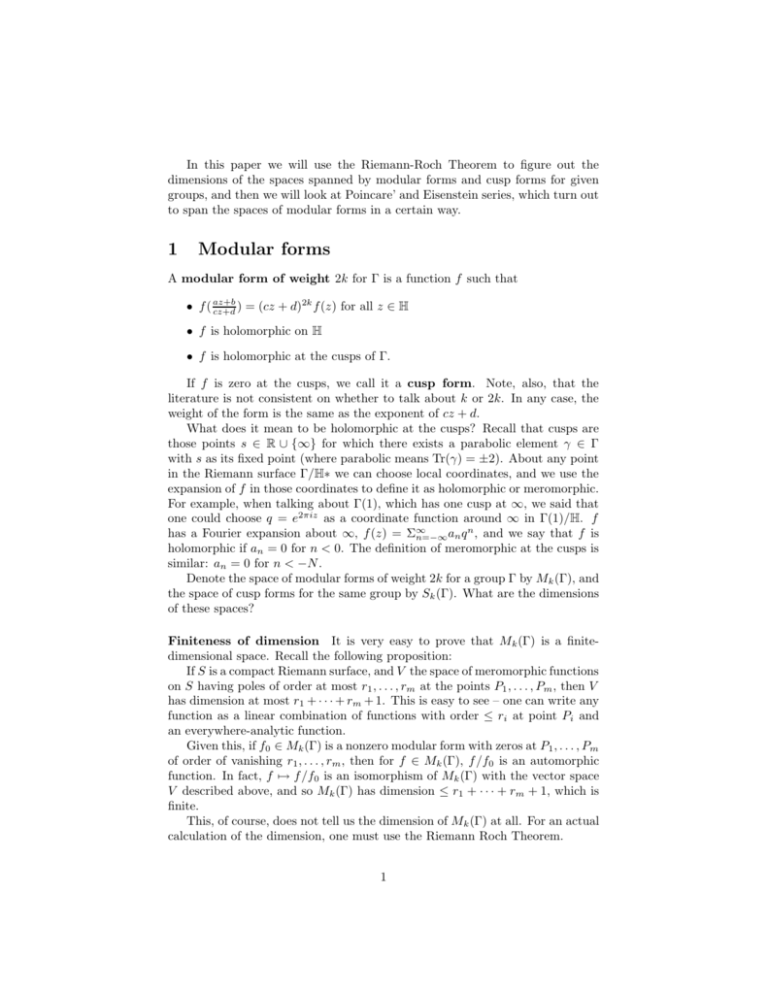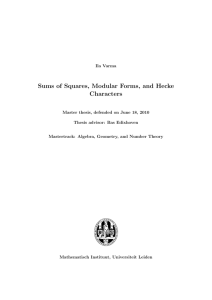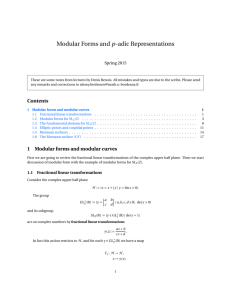Modular forms notes, summer 2005
advertisement

In this paper we will use the Riemann-Roch Theorem to figure out the
dimensions of the spaces spanned by modular forms and cusp forms for given
groups, and then we will look at Poincare’ and Eisenstein series, which turn out
to span the spaces of modular forms in a certain way.
1
Modular forms
A modular form of weight 2k for Γ is a function f such that
2k
• f ( az+b
cz+d ) = (cz + d) f (z) for all z ∈ H
• f is holomorphic on H
• f is holomorphic at the cusps of Γ.
If f is zero at the cusps, we call it a cusp form. Note, also, that the
literature is not consistent on whether to talk about k or 2k. In any case, the
weight of the form is the same as the exponent of cz + d.
What does it mean to be holomorphic at the cusps? Recall that cusps are
those points s ∈ R ∪ {∞} for which there exists a parabolic element γ ∈ Γ
with s as its fixed point (where parabolic means Tr(γ) = ±2). About any point
in the Riemann surface Γ/H∗ we can choose local coordinates, and we use the
expansion of f in those coordinates to define it as holomorphic or meromorphic.
For example, when talking about Γ(1), which has one cusp at ∞, we said that
one could choose q = e2πiz as a coordinate function around ∞ in Γ(1)/H. f
n
has a Fourier expansion about ∞, f (z) = Σ∞
n=−∞ an q , and we say that f is
holomorphic if an = 0 for n < 0. The definition of meromorphic at the cusps is
similar: an = 0 for n < −N .
Denote the space of modular forms of weight 2k for a group Γ by Mk (Γ), and
the space of cusp forms for the same group by Sk (Γ). What are the dimensions
of these spaces?
Finiteness of dimension It is very easy to prove that Mk (Γ) is a finitedimensional space. Recall the following proposition:
If S is a compact Riemann surface, and V the space of meromorphic functions
on S having poles of order at most r1 , . . . , rm at the points P1 , . . . , Pm , then V
has dimension at most r1 + · · · + rm + 1. This is easy to see – one can write any
function as a linear combination of functions with order ≤ ri at point Pi and
an everywhere-analytic function.
Given this, if f0 ∈ Mk (Γ) is a nonzero modular form with zeros at P1 , . . . , Pm
of order of vanishing r1 , . . . , rm , then for f ∈ Mk (Γ), f /f0 is an automorphic
function. In fact, f 7→ f /f0 is an isomorphism of Mk (Γ) with the vector space
V described above, and so Mk (Γ) has dimension ≤ r1 + · · · + rm + 1, which is
finite.
This, of course, does not tell us the dimension of Mk (Γ) at all. For an actual
calculation of the dimension, one must use the Riemann Roch Theorem.
1
Riemann Roch and preliminaries Consider meromorphic functions f (z)
on a Riemann surface S, meromorphic differential forms ω(z) = f (z)dz on S,
and points p ∈ S. As above, f (z) has a Laurent series expansion at any p ∈ S,
m
f (z) = z n Σ∞
m=1 am z , with a0 6= 0. We let νp (f ) = n denote the order of f
at p, and likewise for a differential ω(z) = f (z)dz, let νp (ω) = νp (f ) denote
the order of ω(z) at p. Form a free abelian group on the points of S and call it
the group of divisors: divisors are formal sums of point with integer coefficients
almost all zero. The divisor of f is written θ(f ) = Σp∈S νp (f ) · p, and θ(ω) is
defined similarly. The order of a divisor is |θ| = Σp∈S µp for θ = Σp∈S µp · p.
From complex analysis, it’s easy to see that the divisors of meromorphic
functions f are the kernel of the order homomorphism from the group of divisors
to Z. For a differential form ω, |θ(ω)| = 2(g − 1), where g is the genus of S.
Also, we can put an ordering on the divisors: θ ≥ θ 0 if µp ≥ µ0p for all p.
The Riemann Roch Theorem: Let M be the space of meromorphic functions on S, and L(θ) = {f ∈ M |θ(f ) + θ ≥ 0}. Then for all ω, dim L(θ) =
dim L(θ(ω) − θ) + |θ| + 1 − g.
To compute the dimension of Mk (Γ), we must compare the orders of f ∗ and
f at corresponding points on S = Γ/H∗ and H. Write np (f ) and np (ω) for the
orders on H. At regular points of S, ρ : H → Γ/H is a local isomorphism, so
νp (f ∗ ) = np (f ).
2
The Eisenstein series
Consider a function from a lattice Λ to the complex numbers, where ω denotes
a point on the lattice Λ: Gk (Λ) = Σω∈Λ,ω6=0 1/ω 2k . We can then define Gk (z),
the Eisenstein series, as Gk (z) = Gk (Λ(z, 1)) = Σ(m,n)6=(0,0) 1/(mz + n)2k .
This is clearly weakly modular, and we can prove that it’s holomorphic on H
and takes the value 2ζ(2k) at ∞: thus the Eisenstein series is a modular form
of weight 2k for Γ(1).
Why define this on a lattice? It is rather instructive to look at Gk on
a lattice because there are natural equivalences between the categories of (i)
elliptic curves over C, (ii) Riemann surfaces of genus 1 together with a point
0, and (iii) lattices Λ ∈ C (naming just the objects and leaving you to fill in
the morphisms). This means something... In particular, Gk comes up in the
coefficients of elliptic curves. Something is going on here...
Another way to look at the Eisenstein series is as a space of forms orthogonal
to the cusp forms. The Poincare series of weight 2k and character 0 for Γ(N )
1
is φ0 (z) = Σ (cz+d)
2k , summed over (c, d) = (0, 1) mod N, (c, d) = 1, and this
takes the value 1 at ∞ and vanishes at all other cusps. How could one make a
modular form that takes the value 1 at a cusp P and vanishes at all other cusps?
There is a σ ∈ Γ(1) such that σ(P ) = ∞, so if we let jγ (z) = 1/(cz + d)2 , then
ϕ(z) = jσ (z)k · φ0 (σz) is a modular form of the type desired. Writing this out,
(a) a restricted Eisenstein series of weight 2k for Γ(N ) is the series
G(z; c0 , d0 ; N ) = Σ(cz + d)−2k ,
2
summing over (c, d) = (c0 , d0 ) mod N , (c, d) = 1, and (c0 , d0 ) a pair such that
gcd(c0 , d) , N ) = 1.
(b) a general Eisenstein series of weight 2k > 2 for Γ(N ) is the series
G(z; c0 , d0 ; N ) = Σ(cz + d)−2k ,
summing over (c, d) = (c0 , d0 ) mod N , and (c, d) 6= (0, 0).
There is a distinct restricted Eisenstein series for each cusp, so they are
linearly independent. The general Eisenstein series are the linear combinations
of the restricted Eisenstein series.
3
The Poincare series
Milne says that we would like to construct modular forms for subgroups Γ of
finite index in Γ(1).To do this, we use a method of Poincare. It’s similar to
the standard way of constructing invariant functions — recall the idea that if
h is a function on H, then f (z) = Σγ∈Γ0 h(γz) is invariant under Γ if the series
converges absolutely (Γ0 is the name for the image of Γ in Γ(1)/{±I}. We need
an automorphy factor for Γ in order to adapt this idea. An automorphy
factor is a map j : Γ × H → C× such that
(a) for each γ ∈ Γ, z 7→ jγ (z) is a holomorphic function on H, and (b)
jγγ 0 (z) = jγ (γ 0 z)j̇γ 0 (z).
Try f (z) = Σγ∈Γ0 h(γz)
jγ (z) . If this converges absolutely uniformly on compact
sets, we’ve got it, as
f (γ 0 z) = Σγ∈Γ0
h(γγ 0 z)
h(γγ 0 z)
jγ 0 (z) = jγ 0 (z) · f (z).
= Σγ∈Γ0
0
jγ (γ z)
jγγ 0 (z)
The problem here is that there may be infinitely many γ’s for which jγ (z) =
1, and in this case the sum would not converge. Call the set of γs for which
jγ (z) = 1 identically Γ0 . It is a subgroup of Γ, and we can choose R a set
of coset representatives of Γ mod Γ0 so that Γ = ∪γ∈R Γ0 γ. Then try γ ∈ R
rather than γ ∈ Γ0 for the sum above, and prove convergence on compact sets.
In particular, consider jγ (z) = (cz + d)2k . Notice that Γ0 is the infinite cyclic
subgroup of translations in Γ, z 7→ z + h, and an example of a function invariant
under this action is exp 2πinz/h. Try this for h, to get the Poincare series
φn (z) = ΣΓ0 \Γ0
exp(2πin · γ(z)/h)
.
(cz + d)2k
1
Prove convergence by comparing the sum to Σ(m,n)6=(0,0) |mz+n|
α , which converges for α > 2. This is on the spring 1999 complex prelim so I’ll omit the
proof.
The cool thing about Poincare series is that they span Mk (Γ). We need the
Petersson inner product to prove this.
3
4
Petersson inner product
If f and g are modular forms of weight 2k for a group Γ ∈ Γ(1), and at least
one is a cusp form, then the Petersson inner product of f and g is defined
to be
ZZ
< f, g >=
f (z) · g(z) · y 2k−2 dxdy.
D
It is linear in the first variable, semi-linear in the second; < f, g >= < g, f >;
and < f, f >> 0 for all f 6= 0. So it’s a positive-definite Hermitian form on
Sk (Γ), making Sk (Γ) into a finite dimensional Hilbert space. It’s independent
of the choice of D (fundamental domain of Γ).
Using the Petersson inner product, we can prove that every cusp form is a
linear combination of Poincare series. This follows as an easy corollary from
something that looks a bit more complicated:
Theorem Given f a cusp form for Γ, and φn the Poincare series of the same
weight for Γ, we have
< f, φn >=
h2k (2k − 2)! 1−2k
·n
· an .
(4π)2k−1
Here h is the width of ∞ as a cusp for Γ, and an is the nth coefficient in the
Fourier expansion of f .
If f is orthogonal to all Poincare series, then all its Fourier series coefficients
are zero, and so f must be zero; thus Sk (Γ) is spanned by Poincare series.
Moreover, since the inner product is defined even if only one of the functions
is a cusp form, we can look at the inner product of a cusp form (a linear combination of Poincare series) and an Eisenstein series. One finds (Milne assures
us) that < f, g >= 0 if either f or g is a restricted Eisenstein series, and so in
fact the space of all Eisenstein series is the orthogonal complement of S)k (Γ) in
Mk (Γ).
4











